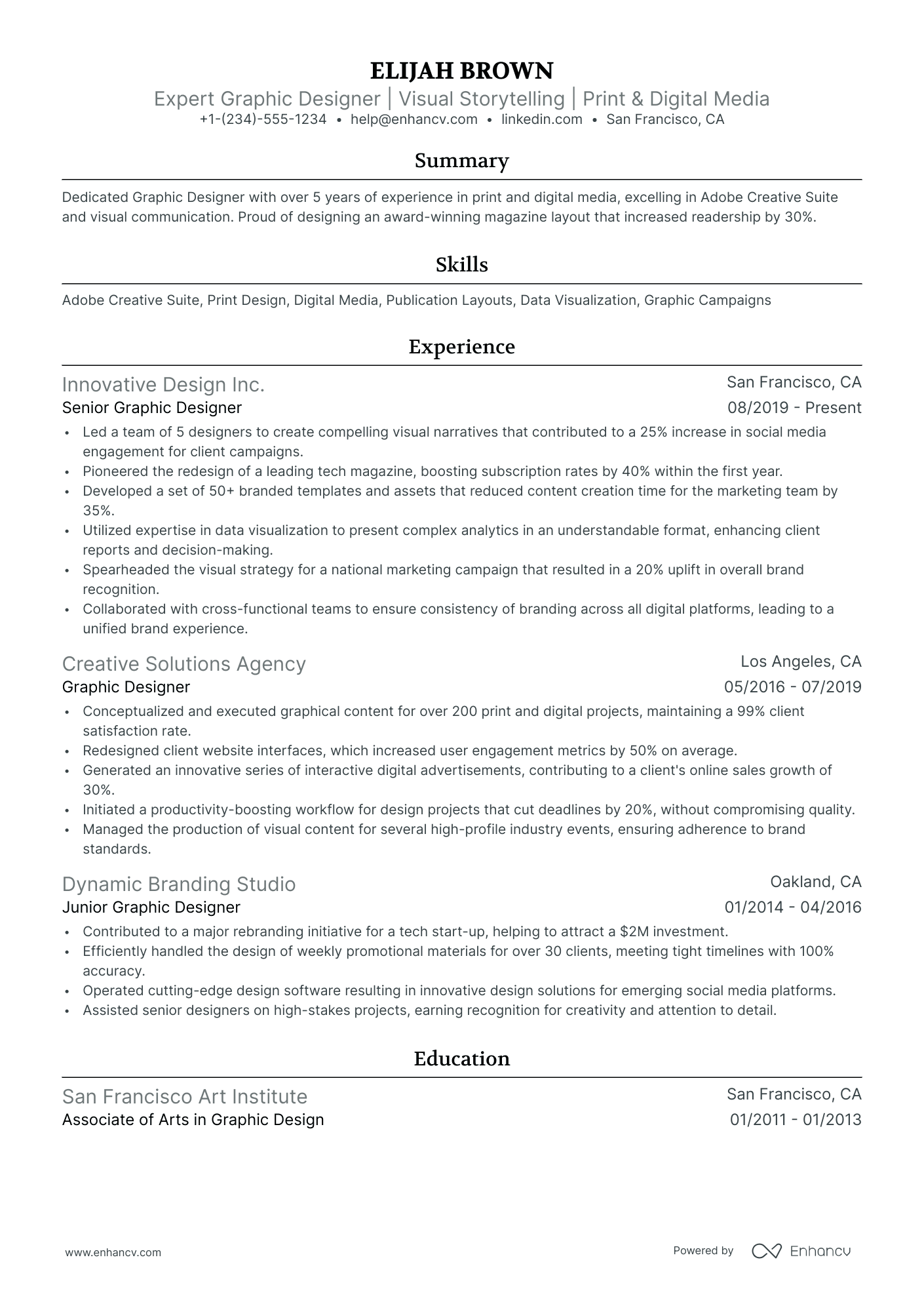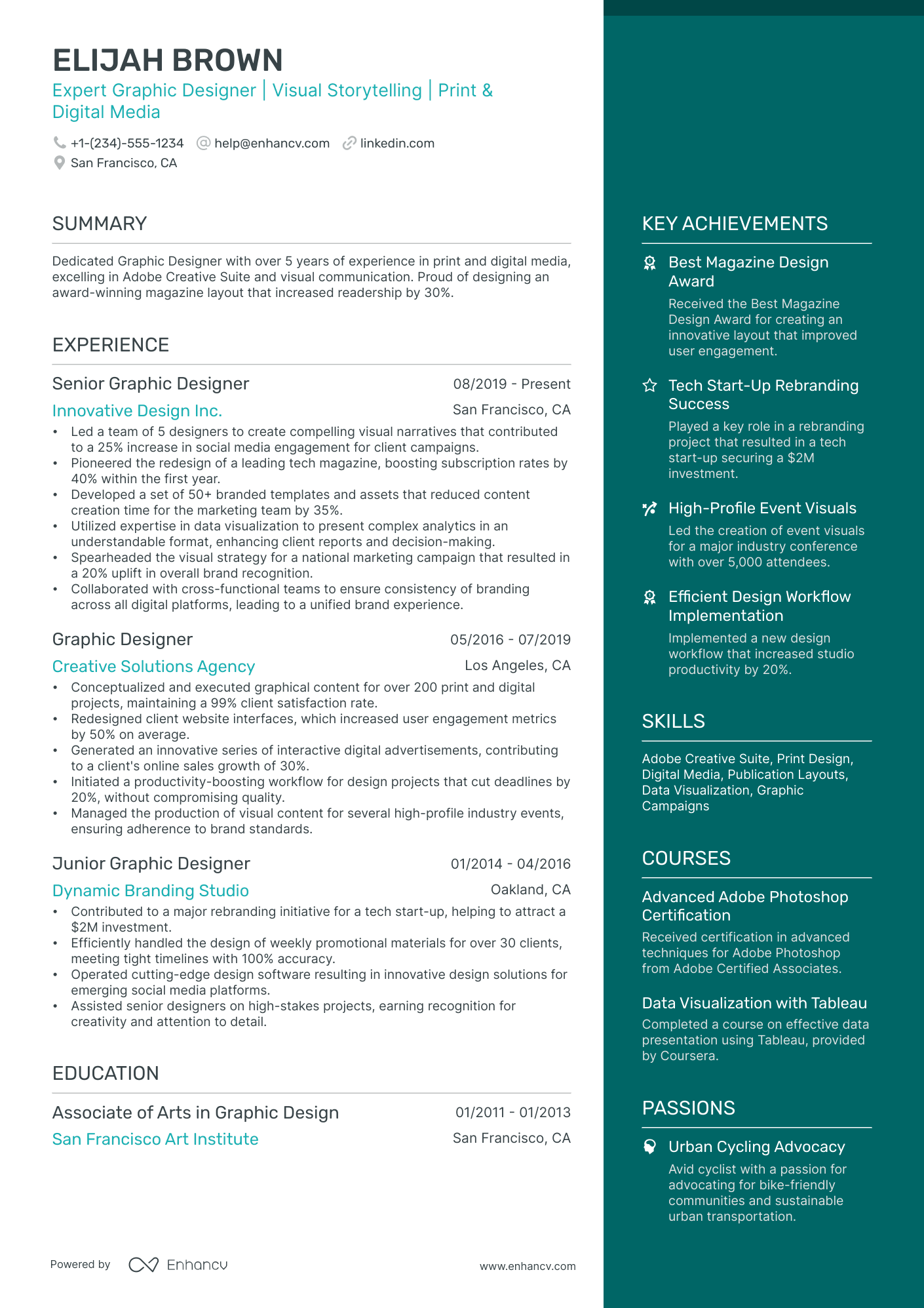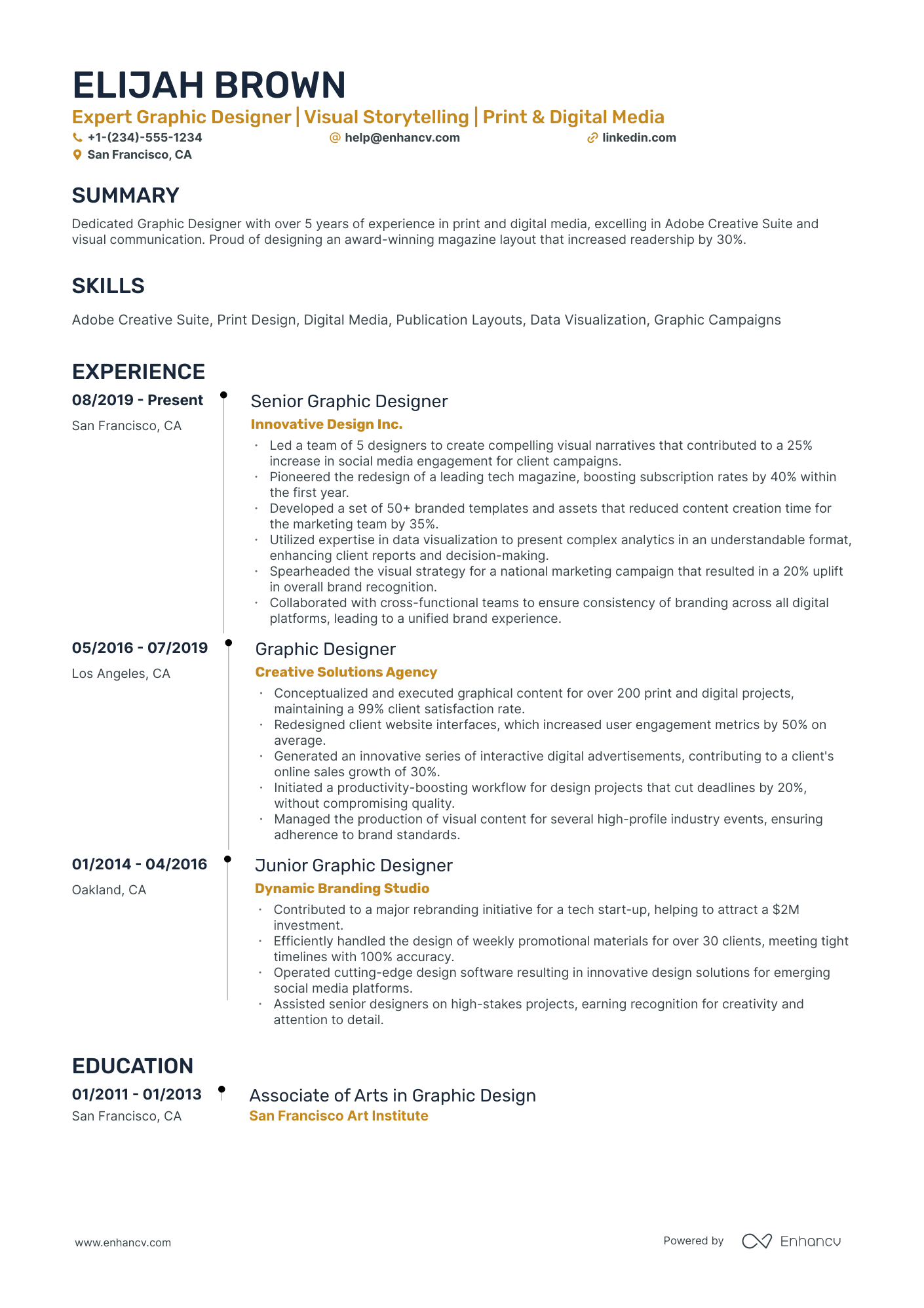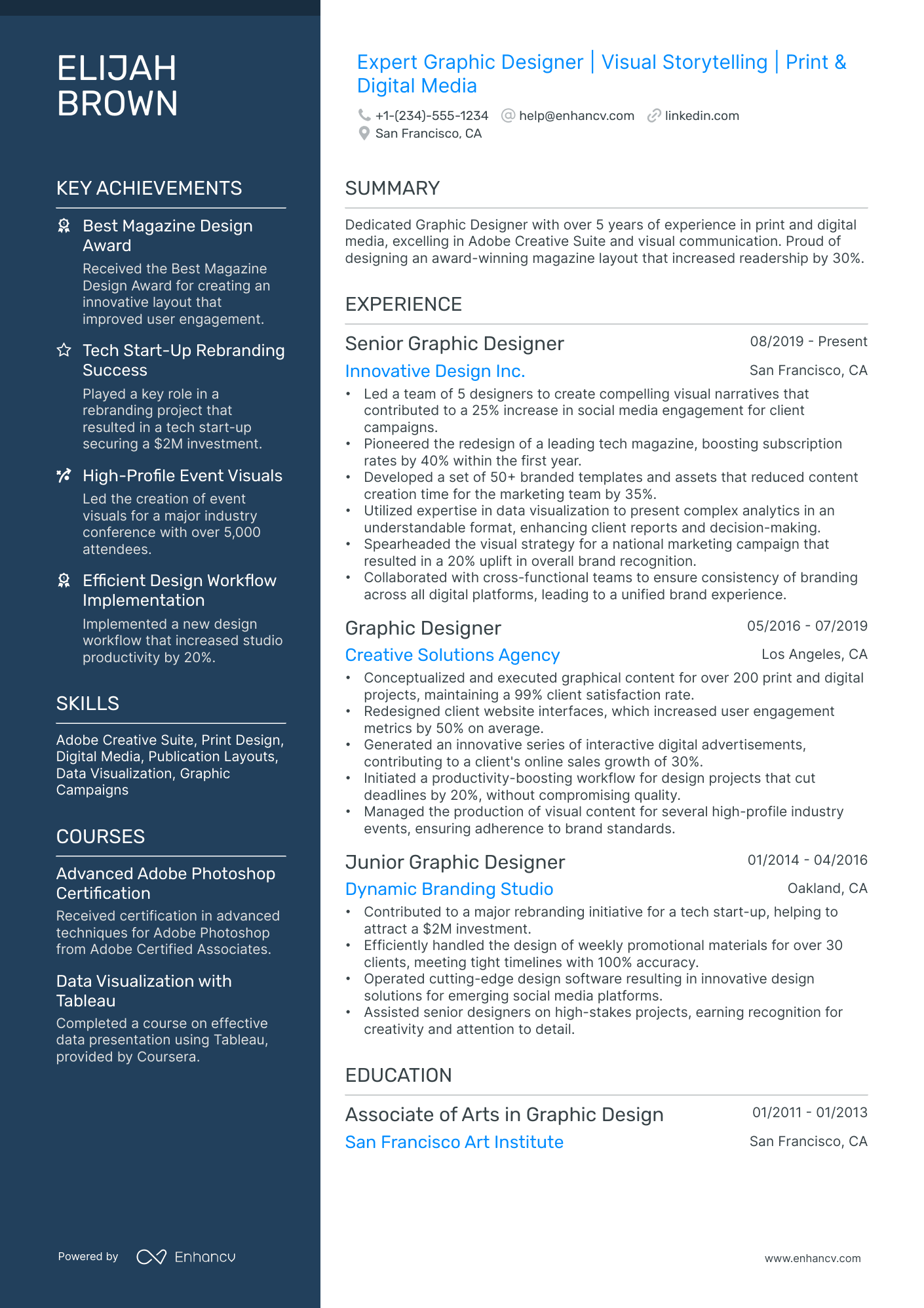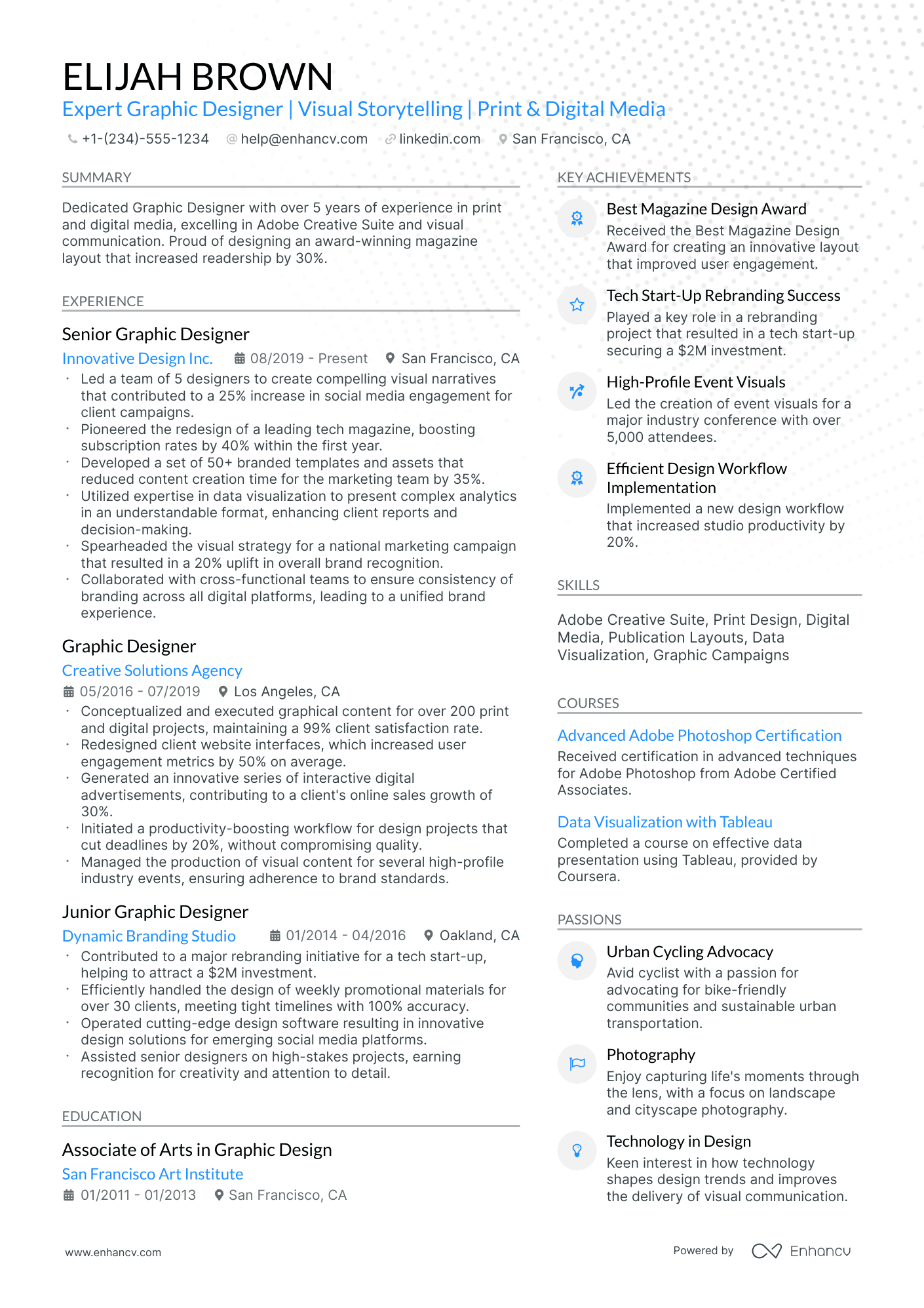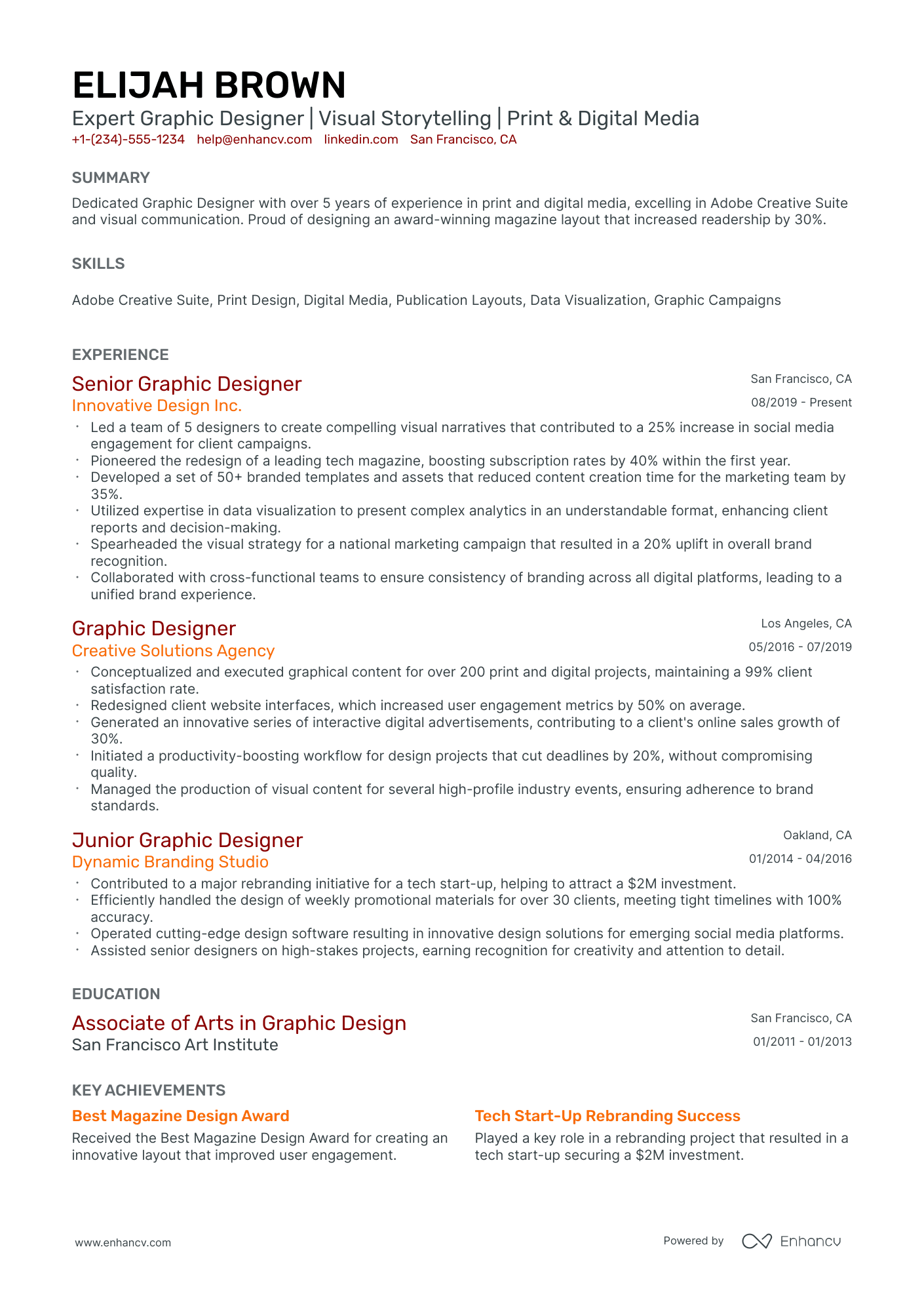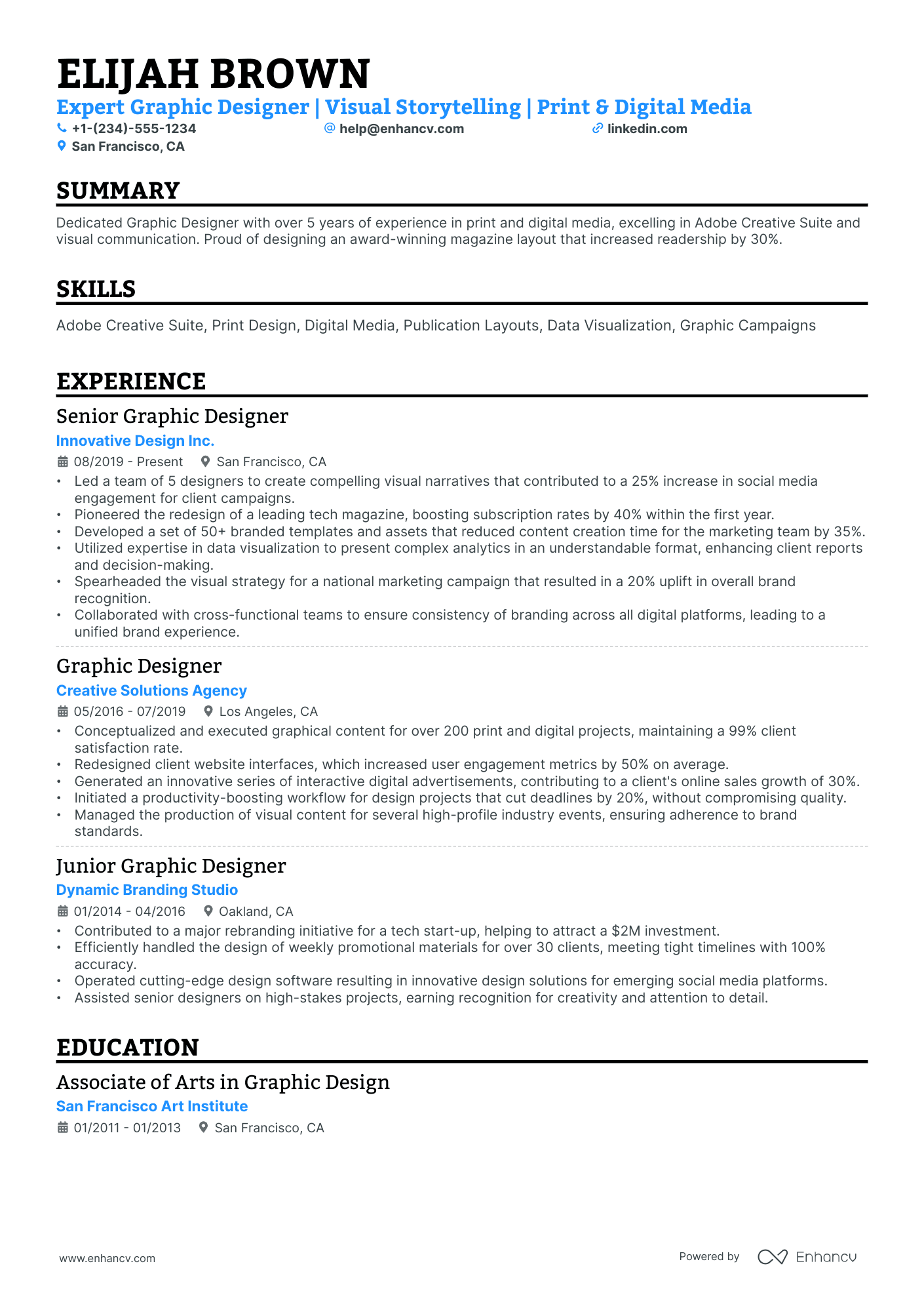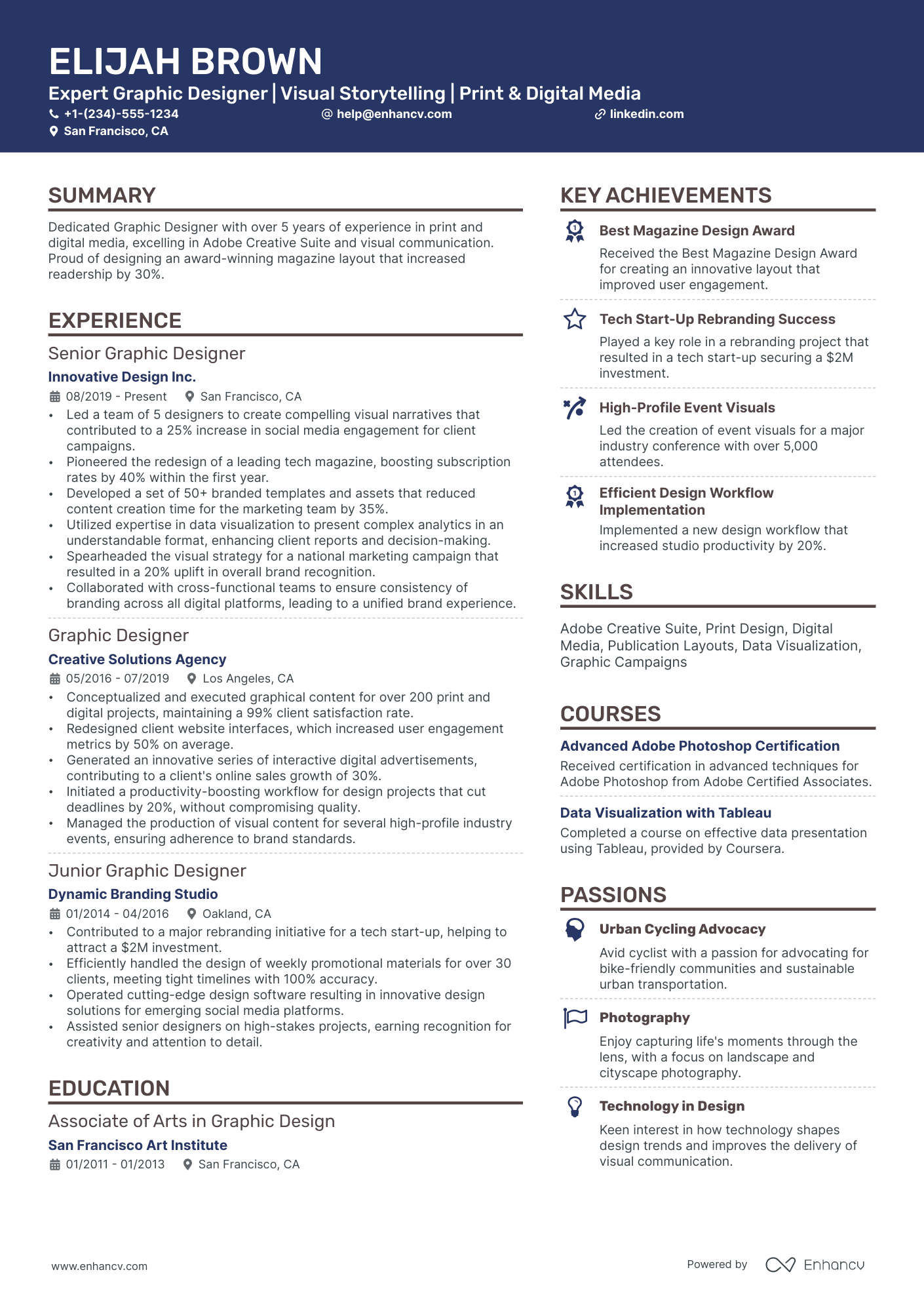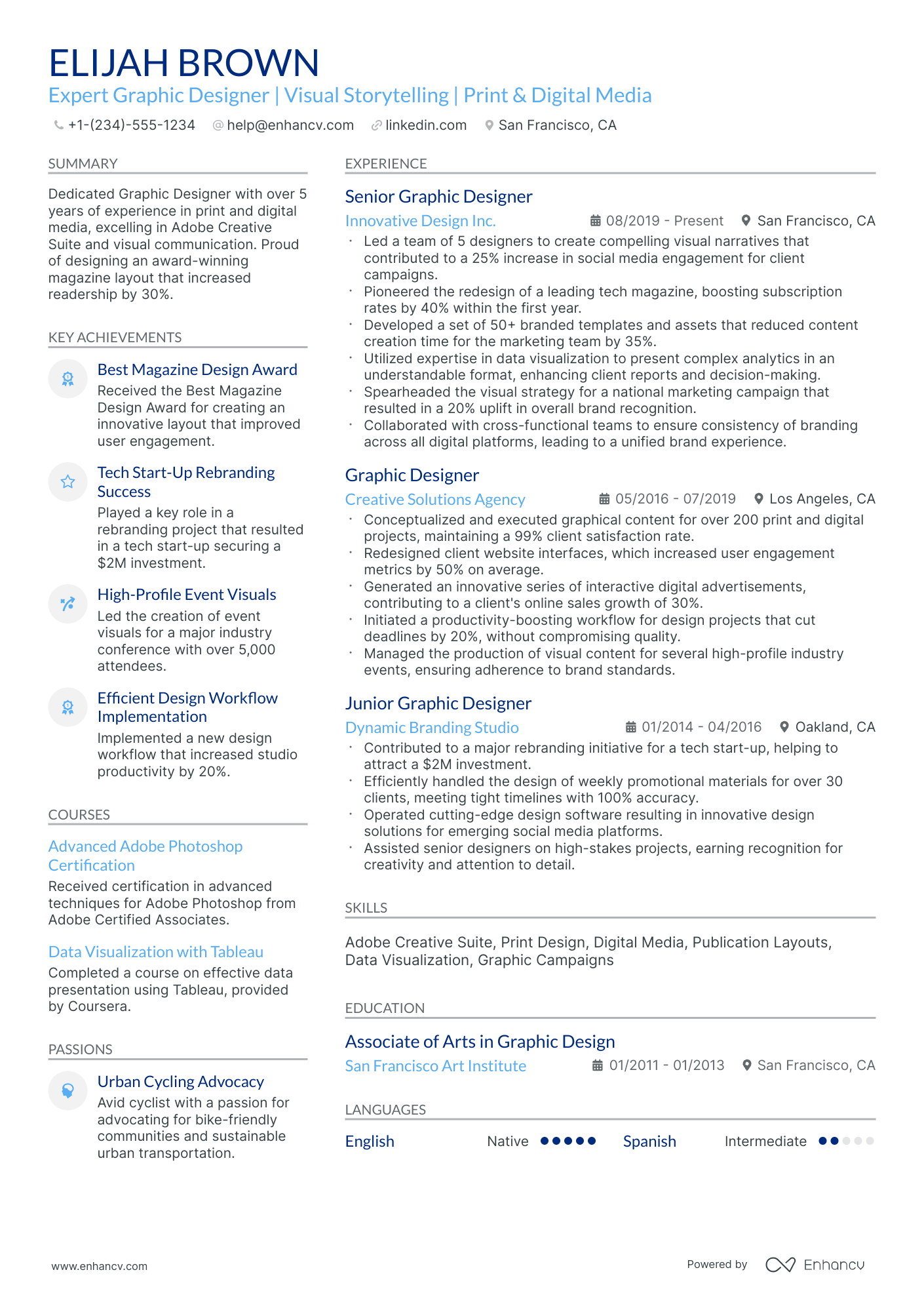As a magazine designer, you might struggle with effectively showcasing your unique blend of visual creativity and layout skills on a traditional resume format. Our comprehensive guide is tailored to help you overcome this challenge by illustrating how to merge your artistic flair with concise content to create a resume that stands out to hiring managers.
- Utilize real-life examples to refine your magazine designer resume;
- Effectively write the experience section of your magazine designer resume, even if you have minimal or no professional experience;
- Incorporate the industry's top 10 essential skills throughout your resume;
- Include your education and certifications to highlight your specific expertise.
If the magazine designer resume isn't the right one for you, take a look at other related guides we have:
- Electrical Designer Resume Example
- CAD Designer Resume Example
- Visual Designer Resume Example
- Digital Designer Resume Example
- Interactive Designer Resume Example
- Assistant Video Editor Resume Example
- Packaging Designer Resume Example
- Narrative Designer Resume Example
- Print Designer Resume Example
- Lighting Designer Resume Example
Creating the best magazine designer resume format: four simple steps
The most appropriate magazine designer resume format is defined by precision and a systematic approach. What is more, it should reflect upon how your application will be assessed by recruiters. That is why we've gathered four of the most vital elements to keep in mind when designing your resume:
- It's all about presenting how your experience or skills align with the job. Use the reverse-chronological resume format , if your expertise is relevant to the magazine designer role. Otherwise, select the functional skill-based resume format or the hybrid resume format to shift the focus to your skill set.
- Resume header - make sure you've filled out all relevant (and correct) information, like your contact details and link to your portfolio.
- Resume length - unless you've over a decade of applicable expertise in the field, stick with a one-page resume format. If you'd like to present more of your professional experience, go up to two pages.
- Resume file - submit your magazine designer resume in a PDF format to ensure all information stays in the same place.
Consider the local standards – Canadian resumes, for example, may have a different format.
Upload & Check Your Resume
Drop your resume here or choose a file. PDF & DOCX only. Max 2MB file size.
PRO TIP
If you're in the process of obtaining your certificate or degree, list the expected date you're supposed to graduate or be certified.
Essential sections that should make up your magazine designer resume include:
- The header - with your contact details (e.g. email and telephone number), link to your portfolio, and headline
- The summary (or objective) - to spotlight the peaks of your professional career, so far
- The experience section - with up to six bullets per role to detail specific outcomes
- The skills list - to provide a healthy mix between your personal and professional talents
- The education and certification - showing your most relevant degrees and certificates to the magazine designer role
What recruiters want to see on your resume:
- Proficiency in graphic design software such as Adobe Creative Suite (InDesign, Photoshop, Illustrator)
- A strong portfolio showcasing layout design, typography skills, and a diverse range of magazine projects
- Understanding of the printing process and prepress specifications for magazines
- Experience with digital publication design and knowledge of current industry trends in digital media
- Ability to manage production schedules and meet tight deadlines in a fast-paced editorial environment
Quick formula for writing your magazine designer resume experience section
Have you ever wondered why recruiters care about your magazine designer expertise?
For starters, your past roles show that you've obtained the relevant on-the job training and expertise that'd be useful for the role.
What is more, the resume work experience section isn't just your work history , but:
- shows what you're capable of achieving based on your past success;
- proves your skills with (oftentimes, tangible) achievements;
- highlights the unique value of what it's like to work with you.
To ensure your resume work experience section is as effective as possible, follow this formula:
- start each bullet with a powerful, action verb , followed up by your responsibilities, and your workplace success.
The more details you can include - that are relevant to the job and linked with your skill set - the more likely you are to catch recruiters' attention.
Additionally, you can also scan the job advert for key requirements or buzzwords , which you can quantify across your experience section.
Not sure what we mean by this? Take inspiration from the magazine designer resume experience sections below:
- Redesigned the monthly layout for 'Urban Trend Magazine,' enhancing the visual aesthetic and improving reader navigation, leading to a 15% increase in subscription renewals.
- Collaboration with photographers and illustrators to create compelling cover art that increased newsstand sales by 20% over two years.
- Implemented a new digital publication strategy that included interactive content for 'Urban Trend Magazine's' digital version, achieving a 30% boost in online readership.
- Pioneered the use of Adobe Digital Publishing Suite within 'EcoLiving Magazine,' which allowed the creation of a more engaging digital reader experience.
- Managed a complete brand redesign that was credited with revitalizing 'EcoLiving Magazine' visual identity and attracting a more diverse audience.
- Supervised a team of junior designers, ensuring consistent quality and maintaining deadlines which contributed to on-time delivery for 24 consecutive issues.
- Led the editorial design team at 'Tech Innovator Magazine,' where we published influential reports that were cited in major technology conferences, influencing industry trends.
- Oversaw a cross-functional team in a successful rebranding initiative that positioned 'Tech Innovator Magazine' as the go-to resource for cutting-edge tech news.
- Streamlined the design process by integrating new software, which reduced production costs by 25% while maintaining the high-quality standard of the magazine's layouts.
- Developed template designs for 'Chic Fashion Magazine' that were flexible enough to accommodate the diverse content each month while maintaining brand coherence.
- Introduced data visualization graphics that simplified complex fashion industry trends, which garnered positive feedback from readers and increased social shares by 35%.
- Managed the design and layout for special editions that corresponded with major fashion events, successfully positioning 'Chic Fashion Magazine' as a key player in fashion journalism.
- Spearheaded a sustainability-focused redesign for 'Global Green Magazine,' which led to the magazine receiving the Eco-Aware Publication award in 2019.
- Orchestrated the transition to a more modern, clean design approach which saw a 18% increase in reader feedback and engagement for 'Global Green Magazine.'
- Coordinated with editorial teams to produce seasonal special issues, highlighting eco-friendly practices around the world, and secured exclusive interviews with high-profile environmentalists.
- Currently innovating the use of augmented reality elements in 'Next Gen Gamer Magazine,' enhancing interactive advertisement content to drive a projected 40% growth in advertiser interest.
- Instrumental in developing a dynamic content layout system to accommodate diverse multimedia content, ranging from game reviews to live event coverage, which improved engagement metrics by 50%.
- Leveraging robust design analytics to inform layout choices leading to the highest engagement times recorded for 'Next Gen Gamer Magazine,' aiming to set industry standards for user retention.
- Drove the rebranding initiative for 'Healthwise Lifestyle Magazine,' fostering a new appeal to a broader demographic and contributing to a 22% increase in circulation numbers.
- Managed the artistic direction for photo shoots and cover designs, frequently resulting in viral social media campaigns that accentuated the impact of 'Healthwise Lifestyle Magazine.'
- Cultivated strategic partnerships with graphic software providers to equip the design team with cutting-edge tools, optimizing production workflow and elevating design quality.
- Responsible for establishing a new design language for 'Adventure World Magazine' that resonated with adventurers and thrill-seekers, resulting in a 38% surge in engagement on digital platforms.
- Developed an effective system for collecting reader feedback and implementing design changes, which significantly improved reader satisfaction scores by 45%.
- Introduced a series of interactive digital features for 'Adventure World Magazine,' such as 360-degree videos and VR content, which generated a new revenue stream from digital content downloads.
The following content includes information from "O*NET OnLine" by the U.S. Department of Labor, Employment and Training Administration (USDOL/ETA). Used under the CC BY 4.0 license. The data represents the top responsibilities present on the task lists for magazine designer professionals.
Top Responsibilities for Magazine Designer:
- Work with creative directors to develop design solutions.
- Present final layouts to clients for approval.
- Manage own accounts and projects, working within budget and scheduling requirements.
- Confer with creative, art, copywriting, or production department heads to discuss client requirements and presentation concepts and to coordinate creative activities.
- Confer with clients to determine objectives, budget, background information, and presentation approaches, styles, and techniques.
- Formulate basic layout design or presentation approach and specify material details, such as style and size of type, photographs, graphics, animation, video, and sound.
- Review and approve art materials, copy materials, and proofs of printed copy developed by staff members.
- Create custom illustrations or other graphic elements.
- Attend photo shoots and printing sessions to ensure that the products needed are obtained.
- Review illustrative material to determine if it conforms to standards and specifications.
Quantifying impact on your resume
- Highlight the number of magazine issues you've successfully designed to demonstrate your experience and productivity.
- Include the percentage increase in subscription or sales figures following a redesign you executed to show your direct impact on revenue.
- Mention the specific number of layout templates you’ve created to showcase your versatility and creativity.
- Specify the amount of time you've reduced in the production cycle through efficient design processes to display your time management skills.
- List the number of design awards or recognitions you've received to establish your credibility and excellence in the field.
- Document the number of photo shoots or visual campaigns you have directed to highlight your leadership and project management abilities.
- State the percentage of cost savings achieved through negotiating with vendors or utilizing more efficient software to show your contribution to profitability.
- Include the number of design team members you've trained or managed to underline your mentoring and team-building skills.
Action verbs for your magazine designer resume
What can candidates do about their resume, if they have no experience
Job requirements can sometimes be answered by other elements you could make more prominent in your magazine designer resume.
Thus, you'd be substituting your lack of experience with your relevant:
- Education with details of skills you've obtained that align with the job
- Internships and short-term jobs that are once more dedicated to putting your expertise in the spotlight
- Skills section answering basic and - potentially - more specific job qualifications
- Strengths or accomplishments to show the unique value you present, even as a candidate with less or no professional experience in the industry.
Recommended reads:
PRO TIP
The more time and effort you've put into obtaining the relevant certificate, the closer to the top it should be listed. This is especially important for more senior roles and if the company you're applying for is more forward-facing.
Defining your unique magazine designer skill set with hard skills and soft skills
In any job advertisement, a blend of specific technologies and interpersonal communication skills is typically sought after. Hard skills represent your technical expertise and indicate your job performance capacity. Soft skills, on the other hand, demonstrate how well you would integrate within the company culture.
Incorporating a balanced mix of both skill types in your magazine designer resume is crucial. Here's how you can do it:
- In your resume summary or objective, incorporate up to three hard and/or soft skills. Make sure to quantify these skills with relevant or impressive achievements; less
- The skills section should list your technical know-how.
- The strengths section is an ideal place to quantify your competencies by focusing on the achievements facilitated by these skills.
Top skills for your magazine designer resume:
Adobe InDesign
Adobe Photoshop
Adobe Illustrator
QuarkXPress
HTML/CSS
Typography
Color Theory
Print Production
Layout Design
Digital Publishing
Creativity
Attention to Detail
Time Management
Communication
Collaboration
Problem Solving
Adaptability
Critical Thinking
Organization
Client Relations
Next, you will find information on the top technologies for magazine designer professonals from "O*NET OnLine" by the U.S. Department of Labor, Employment and Training Administration (USDOL/ETA). Used under the CC BY 4.0 license.
Top technologies for Magazine Designer’s resume:
- AJAX
- Cascading style sheets CSS
- Adobe After Effects
- YouTube
- Adobe Creative Cloud software
- Adobe Illustrator
PRO TIP
If you happen to have some basic certificates, don't invest too much of your magazine designer resume real estate in them. Instead, list them within the skills section or as part of your relevant experience. This way you'd ensure you meet all job requirements while dedicating your certificates to only the most in-demand certification across the industry.
The magazine designer resume sections you may underestimate: certifications and education
Your education and certifications provide insight into both your technical capabilities and personal attributes, such as perseverance. When crafting your magazine designer resume, consider how you present these elements:
- For your higher education degrees, prioritize listing those most relevant to the job or indicative of your academic dedication;
- Include applicable coursework as a stand-in for relevant experience or if it might impress recruiters;
- Include incomplete higher education only if it's pertinent to meeting job requirements;
- If your degree is from a renowned university, mention how often you made the Dean's list to underline academic excellence.
Regarding certifications, it's not necessary to list all of them. Instead, match up to three of your most recent or significant certificates with the technical skills required in the job description.
Below, we've selected some of the top industry certifications that could be vital additions to your magazine designer resume.
The top 5 certifications for your magazine designer resume:
- Adobe Certified Expert (ACE) - Adobe
- Certified Graphic Designer (CGD) - Graphic Designers of Canada (GDC)
- Graphic Design Certification (GDC) - Sessions College for Professional Design
- User Experience (UX) Design Certification - Nielsen Norman Group (NN/g)
- Digital Publishing Suite ACE Certification - Adobe
The content below includes information from "O*NET OnLine" by the U.S. Department of Labor, Employment and Training Administration (USDOL/ETA). Used under the CC BY 4.0 license. The data represents the top associations for magazine designer professionals.
Top US associations for a Magazine Designer professional
- Professional Association for Design
- Promax International BPME
- The One Club for Creativity
PRO TIP
List your educational qualifications and certifications in reverse chronological order.
Recommended reads:
Adding a summary or objective to your magazine designer resume
One of the most crucial elements of your professional presentation is your resume's top one-third. This most often includes:
- Either a resume summary - your career highlights at a glance. Select the summary if you have plenty of relevant experience (and achievements), you'd like recruiters to remember about your application.
- Or, a resume objective - to showcase your determination for growth. The perfect choice for candidates with less experience, who are looking to grow their career in the field.
If you want to go above and beyond with your magazine designer resume summary or resume objective, make sure to answer precisely why recruiters need to hire you. What is the additional value you'd provide to the company or organization? Now here are examples from real-life magazine designer professionals, whose resumes have helped them land their dream jobs:
Resume summaries for a magazine designer job
- Passionate magazine designer with over 7 years of experience crafting compelling layouts for high-fashion publications. Proficient in Adobe Creative Suite and renowned for elevating brand aesthetics through innovative design. Awarded "Best Magazine Spread" in 2021 by the Designer's Forum for excellence in visual storytelling.
- Experienced Graphic Designer transitioning to Magazine Design, bringing a decade of expertise in creating engaging visuals for digital media agencies. Skilled in Photoshop, InDesign, and Illustrator, eager to apply a deep understanding of brand identity to produce stimulating magazine layouts that resonate with diverse audiences.
- Former Photojournalist now pursuing a creative path in Magazine Design, equipped with a sharp eye for detail and 5 years’ experience in fast-paced news environments. Brings a unique narrative approach to design, adept in photo editing and composition, seeking to leverage storytelling skills to create impactful magazine visuals.
- Adept in multimedia design and layout, I've dedicated 8 years to producing captivating visual content for online platforms. Transitioning into Magazine Design, my goal is to merge digital design expertise with traditional print media, offering a fresh perspective to revitalize and engage new reader demographics.
- Eager to embark on a career in Magazine Design, I am a recent Visual Arts graduate with a strong foundation in color theory, typography, and digital illustration. Committed to leveraging academic training and a fresh, creative outlook to deliver groundbreaking magazine designs that push the boundaries of visual communication.
- As an aspiring magazine designer with a passion for the vibrant world of fashion and lifestyle publications, and a solid background in art and design principles gained through rigorous academic coursework, my objective is to infuse modern design trends with classic aesthetics to create unforgettable magazine experiences for a new generation of readers.
Optimize your resume summary and objective for ATS
Drop your resume here or choose a file.
PDF & DOCX only. Max 2MB file size.
Average salary info by state in the US for magazine designer professionals
Local salary info for Magazine Designer.” Source: My Next Move, National Center for O*NET Development. Accessed 10/15/2024
| State | Average Salary (in USD) |
|---|---|
| US National Average | $106,500 |
| California (CA) | $130,610 |
| Texas (TX) | $80,940 |
| Florida (FL) | $92,000 |
| New York (NY) | $150,830 |
| Pennsylvania (PA) | $88,150 |
| Illinois (IL) | $102,050 |
| Ohio (OH) | $91,700 |
| North Carolina (NC) | $90,790 |
| Michigan (MI) | $86,360 |
More sections to ensure your magazine designer resume stands out
If you're looking for additional ways to ensure your magazine designer application gets noticed, then invest in supplementing your resume with extra sections, like:
These supplementary resume sections show your technical aptitude (with particular technologies and software) and your people skills (gained even outside of work).
Key takeaways
Writing your magazine designer resume can be a structured and simple experience, once you better understand the organization's requirements for the role you're applying to. To sum up, we'd like to remind you to:
- Always select which experiences, skills, and achievements to feature on your resume based on relevancy to the role;
- In your resume summary, ensure you've cherry-picked your top achievements and matched them with the job ad's skills;
- Submit your magazine designer resume as a one or two-page long document at the most, in a PDF format;
- Select industry leading certifications and list your higher education to highlight you have the basis for technical know-how;
- Quantify your people's skills through various resume sections (e.g. Strengths, Hobbies and interests, etc.) to show recruiters how your profile aligns with the organizational culture.
